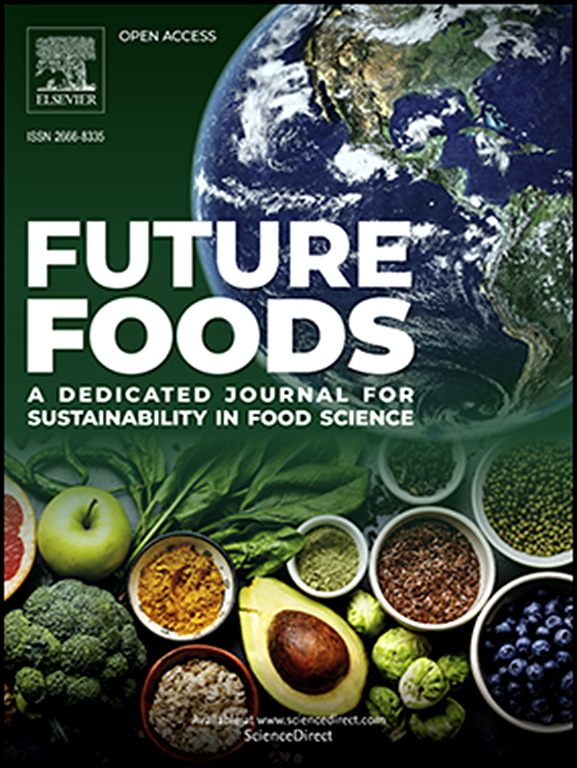Enhancing fish drying efficiency and quality: A comparative study of intermittent microwave convective drying (IMCD) and conventional methods
IF 8.2
Q1 FOOD SCIENCE & TECHNOLOGY
引用次数: 0
Abstract
Microwave (MW) heating offers a unique drying mechanism which pushes internal moisture to the surface during the drying of water-rich foods including fish. However, the continuous application of MW energy causes excessive localized heating, resulting in the deterioration of food quality. Although intermittent microwave convective drying (IMCD) is recognized as an advanced drying technology that addresses the limitations of conventional microwave, convective, and combined microwave convective drying methods, its practical application remains limited. Notably, there is inadequate research on the use of IMCD for fish drying. This study addresses this critical gap by investigating the effects of microwave intermittency on drying kinetics, energy consumption, and key quality attributes of fish, including shrinkage, rehydration capacity and visual appearance. Convective drying (CD), microwave convective drying (CMW) drying and IMCD, was conducted to compare the drying kinetics energy consumption and quality of dried fish fillet. It was found that IMCD took only 12 min to complete the drying process, whereas CD took approximately 300 min. IMCD provided achieved better, dried fish samples achieved superior quality, drying time was reduced by 90 % and energy consumption was reduced by 20 % in comparison with convective drying. Moreover, pattern of shrinkage, changes of colour, uniformity of colour, rehydration capasity are found better in the IMCD dried fish sample. These findings clearly establish IMCD as the best drying method for fish drying particularly at industry level. MW drying takes around 10–20 times less time than convective drying to remove the same quantity of moisture. IMCD exhibits an exergy efficiency of 23.84 %, which is higher than convective drying (14.99 %) and closer to CMW drying (21.45 %). This indicates that IMCD has a more efficient utilization of energy for useful work output. The appearance and protein content properties of the IMCD dried fish fillet appeared better than those of CD and CMW dried samples. Furthermore, the least shrinkage and superior rehydration capacity were observed in IMCD dried samples. This study also identifies the need for further optimization and integration of real-time monitoring technologies to enhance energy efficiency and product quality, highlighting the broader industrial relevance and future development potential of IMCD in fish drying applications.

提高鱼类干燥效率和品质:间歇微波对流干燥(IMCD)与常规干燥方法的比较研究
微波(MW)加热提供了一种独特的干燥机制,在干燥富含水分的食物(包括鱼)时,将内部水分推到表面。然而,持续使用兆瓦能量会造成过度的局部加热,导致食品质量恶化。间歇微波对流干燥(IMCD)是一种先进的干燥技术,它解决了传统微波、对流和微波对流联合干燥方法的局限性,但其实际应用仍然有限。值得注意的是,关于使用IMCD烘干鱼类的研究不足。本研究通过研究微波间歇对干燥动力学、能量消耗和鱼的关键品质属性(包括收缩率、再水化能力和视觉外观)的影响,解决了这一关键空白。采用对流干燥法(CD)、微波对流干燥法(CMW)和微波对流干燥法(IMCD)对鱼干鱼片的干燥动力学、能量消耗和品质进行了比较。研究发现,IMCD的干燥过程只需要12分钟,而CD则需要大约300分钟。与对流干燥相比,IMCD提供了更好的干燥效果,干鱼样品获得了更好的质量,干燥时间减少了90%,能耗减少了20%。此外,IMCD鱼干样品的收缩模式、颜色变化、颜色均匀性和复水能力都较好。这些发现清楚地表明,IMCD是鱼类干燥的最佳干燥方法,特别是在工业水平上。MW干燥所需的时间比对流干燥少10-20倍,以去除相同数量的水分。IMCD的火用效率为23.84%,高于对流干燥(14.99%),接近CMW干燥(21.45%)。这表明IMCD能够更有效地利用能量进行有用的工作输出。IMCD干鱼片的外观和蛋白质含量优于CD和CMW干鱼片。此外,IMCD干燥样品的收缩率最小,再水化能力较好。本研究还确定需要进一步优化和整合实时监测技术,以提高能源效率和产品质量,突出了IMCD在鱼类干燥应用中的更广泛的工业相关性和未来发展潜力。
本文章由计算机程序翻译,如有差异,请以英文原文为准。
求助全文
约1分钟内获得全文
求助全文
来源期刊

Future Foods
Agricultural and Biological Sciences-Food Science
CiteScore
8.60
自引率
0.00%
发文量
97
审稿时长
15 weeks
期刊介绍:
Future Foods is a specialized journal that is dedicated to tackling the challenges posed by climate change and the need for sustainability in the realm of food production. The journal recognizes the imperative to transform current food manufacturing and consumption practices to meet the dietary needs of a burgeoning global population while simultaneously curbing environmental degradation.
The mission of Future Foods is to disseminate research that aligns with the goal of fostering the development of innovative technologies and alternative food sources to establish more sustainable food systems. The journal is committed to publishing high-quality, peer-reviewed articles that contribute to the advancement of sustainable food practices.
Abstracting and indexing:
Scopus
Directory of Open Access Journals (DOAJ)
Emerging Sources Citation Index (ESCI)
SCImago Journal Rank (SJR)
SNIP
 求助内容:
求助内容: 应助结果提醒方式:
应助结果提醒方式:


